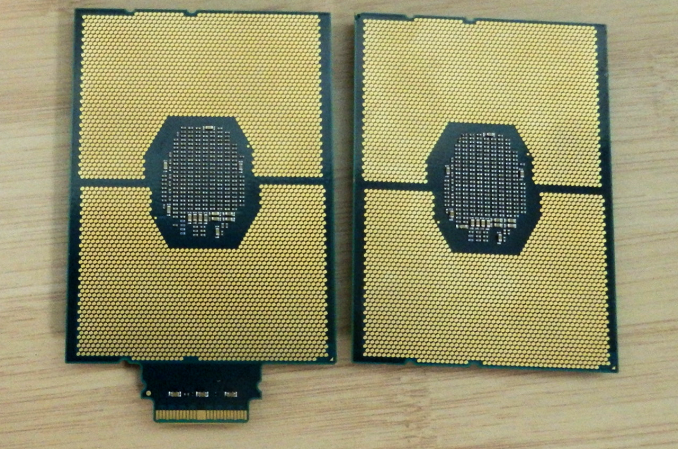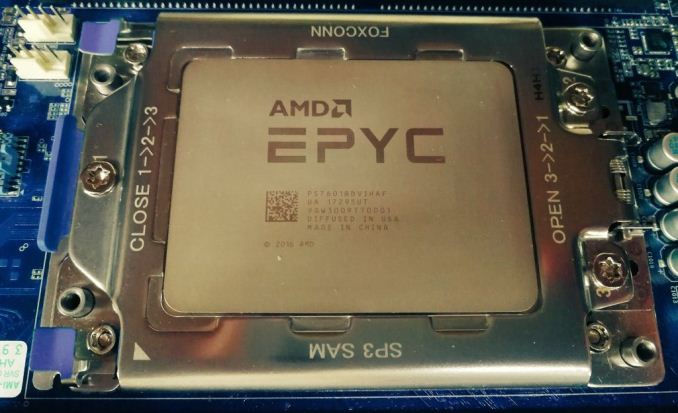Dissecting Intel's EPYC Benchmarks: Performance Through the Lens of Competitive Analysis
by Johan De Gelas & Ian Cutress on November 28, 2017 9:00 AM EST- Posted in
- CPUs
- AMD
- Intel
- Xeon
- Skylake-SP
- Xeon Platinum
- EPYC
- EPYC 7601
Conclusion
First of all, Intel's benchmarks lend further support to what we already suspected: Intel's Scalable Xeon is better at serving databases for a number of reasons: better data locality (fewer NUMA nodes), better single-threaded performance, and a more "useable" cache. The claim that Intel offers much more predictable database performance seems very reasonable to us: the EPYC platform is much younger and much more complex to tune as it is a "virtual 8 socket" system.
Secondly it is true that the Intel Scalable Xeon is more versatile: the past 5 years AMD's presence in the server market was neglible, while Intel has been steadily adding virtualization features (posted interrupts), I/O features and more (TSX for example). Many of these features are now supported by the hypervisor and OSes out there.
The EPYC platform has some catching up to do. Firmware updates and other software updates were necessary to run a hypervisor, and only relatively recent versions of the Linux kernel (February 2017 w/4.10+) have support for the EPYC processor. So even if we doubt that the 8160 can really deliver 37% better performance than the AMD EPYC in the real world, there is no denying that the Intel Xeon is a "safer bet" for VMware virtualization.
Nevertheless, it is interesting to see that Intel admits that there are quite a few use cases out there where AMD has an advantage. The AMD EPYC has a performance per dollar advantage in webserving and Java servers, for example.
Otherwise, there is some merit to the claim that AVX-512 allows Intel to offer excellent HPC performance without the use of a GPU in compute intensive applications. At the same time, if you are after the best performance on these very parallel workloads, a GPU almost always offers several times higher performance. AVX-512 can also not save Intel in several bandwidth-intensive benchmarks such, as in fluid dynamics.

Intel Xeon-SP CPUs (Left: with Omni-Path)
One interesting element to the whole scenario is that at no point does Intel ever approach the performance per watt angle in these discussions. It leaves a big question unanswered from Intel - perhaps we should invoke Hanlon's Razor at this point and call it a missed opportunity, rather than suggest that Intel does not want to speak about power. Our own results showed a win for AMD's EPYC here though, when comparing two 145W Xeon 8176 parts to two 180W EPYC 7601 parts. More testing on specific workloads is needed.
In summary, Intel makes several good points, even when those points aren't always in their own favor. The company clearly has an interest in ensuring that the Xeon's performance leadership remains well-known in light of AMD's EPYC-fueled resurgence, and while there's nothing altruistic about Intel's benchmarking, they are working from a sound position. Still, in defending their position – and by extension their high margins – Intel does highlight the Xeon's biggest weakness versus the EPYC in this newly competitive market: the Skylake Xeon can offer excellent performance, but that performance comes with an equally heavy price tag.

















105 Comments
View All Comments
Johan Steyn - Monday, December 18, 2017 - link
I am so glad people are realising ANandtechs rubish, probably led by Ian who wrote that terrible Threadripper review. Maybe he will realise it as more complain. It all depends on how much Intel is paying him...mapesdhs - Wednesday, November 29, 2017 - link
ANSYS is one of those cases where having massive RAM really matters. I doubt if any site would bother speccing out a system properly for that. One ANSYS user told me he didn't care about the CPU, just wanted 1TB RAM, and that was over a decade ago.rtho782 - Tuesday, November 28, 2017 - link
> Xeon Platinum 8160 (24 cores at 2.1 - 3.7 GHz, $4702k)$4,702,000? Intel really have bumped up their pricing!!
bmf614 - Tuesday, November 28, 2017 - link
The pricetag discussion really needs to include software licensing as well. Windows Datacenter and SQL server on a machine with 64 cores will cost more than the hardware itself. This is the reason that the Xeon 5122 exists.bmf614 - Tuesday, November 28, 2017 - link
Also isnt it kind of silly to invest in a server platform with limited PCIE performance when faster and faster storage and networking is becoming commonplace?Polacott - Tuesday, November 28, 2017 - link
it really seems that AMD has crushed Intel this time. Also Charlie has some interest points about security ( has this topic being even analyzed here ? https://www.semiaccurate.com/2017/11/20/epyc-arriv... )Software WILL be tuned for Epyc, so a safe bet will not be getting Xeon but Epic, for sure.
And power consumption and heat is really important as is an interesting part of datacenter maintenance costs.
I really don't get how the article ends up in this conclusion.
Johan Steyn - Monday, December 18, 2017 - link
Intel's financial support helps them reach this conclusion. Very sadZolaIII - Tuesday, November 28, 2017 - link
As usually Intel cheated. Clients won't use neither their property compiler nor a software but GNU one's. Now let me show you a difference:https://3s81si1s5ygj3mzby34dq6qf-wpengine.netdna-s...
Other than that this is boring as ARM NUMA based server chips are coming with some backup from good old veterans when it comes to to supercomputing and this time around Intel won't have even a compiler advantage to drag about it.
Sources:
https://www.nextplatform.com/2017/11/27/cavium-tru...
http://www.cavium.com/newsevents-Cray-Catapults-Ar...
Now this are the real news & melancholic ones for me as it brings back memories how it all started. & guess what? We are back their on the start again.
toyotabedzrock - Tuesday, November 28, 2017 - link
Linux 4.15 has code to increase EPYC performance and enable the memory encryption features. 4.16 will have the code to enable the virtual machine memory encryption.duploxxx - Friday, December 1, 2017 - link
thx for sharing the article Johan, as usual those are the ones I will always read.Interesting to get feedback from Intel on benchmark compares, this tells how scared they really are from the competition. There is no way around, I' ve been to many OEM and large vendor events lately. One thing is for sure, the blue team was caught with there pants down and there is for sure interest from IT into this new competitor.
Now talking a bit under the hood, having had both systems from beta stages.
I am sure Intel will be more then happy to tell you if they were running the systems with jitter control. Off course they wont tell the world about this and its related performance issues.
Second, will they also share to the world that there so called AVX enhancement have major clock speed disadvantages to the whole socket. really nice in virtual environments :)
Third, the turbo boosting that is nowhere near the claimed values when running virtualization?
Yes the benchmarking results are nice, but they don't give real world reality, its based on synthetic benches. Real world gets way less turbo boost due to core hot spots and there co-related TDP.
There are reasons why large OEM did not yet introduce EPYC solutions, they are still optimizing BIOS and microcode as they want to bring a solid performing platform. The early tests from Intel show why.
Even the shared VMware bench can be debated with no shared version info as the 6.5u1 has got major updates to the hypervisor with optimizations for EPYC.
Sure DB benches are an Intel advantage, there is no magic to it looking at the die configurations, there are trade offs. But this is ONLY when the DB are bigger then certain amount of dies so we are talking here about 16+ cores from the 32 cores/socket systems for example, anything lower will have actually more memory bandwidth then the Intel part. So how reliable are these benchmarks for a day to day production.... not all are running the huge sizes. And those who do should not just compare based on synthetical benches provided but do real life testing.
Aint it nice that a small company brings a new CPU line and already Intel needs to select there top bin parts as a counter part to show benchmarks to be better. There are 44 other bins available on the Intel portfolio, you can probably already start guessing how well they really fare against there competitor....